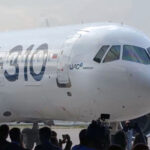The Central Aerohydrodynamic Institute named after Professor N.E. Zhukovsky (TsAGI) is one of the key enterprises performing ground static and life-cycle certification tests for the import substitution of the main units and systems of the SJ-100 aircraft. In the interests of the aircraft developer, PJSC Yakovlev, TsAGI completed a large-scale cycle of research of the SJ-100 model with PD-8 engines. The final stage was tests in the T-106 transonic wind tunnel.
“The past experiments completed an extensive cycle of work to study the aerodynamic performance of the SJ-100 with the new engine. During the year, the experiments took place in TsAGI’s pre- and transonic wind tunnels. The data obtained are used by the design bureau in preparation for flight tests of the aircraft with the new engine,” commented Ivan Chernyshev, Deputy Head of the Aircraft Aerodynamics Department of TsAGI FAU, Candidate of Technical Sciences.
Creation of the closed-type wind tunnel T-106 began in 1938. At the end of December 1942 the tube was put into operation. Since the first days of its existence, T-106 has been an integral part of TsAGI’s experimental base. One of the first aircraft tested was the Yak-3 fighter. T-106 is designed to study aerodynamic characteristics of aircraft models and their components at subsonic and transonic speeds. The flow in the tube is created by an electrically driven compressor with a capacity of 32 MW.

The circular cross-sectional working part with a perforated wall is equipped with electromechanical and a set of strain gauge weights for measuring aerodynamic forces and moments of models and their elements, as well as supporting devices of three types: belt suspension, tail holder and sub-fuselage strut. T-106 is equipped with an automated measuring, computing and control complex for control, registration, data collection and processing during the experiment.
The SJ-100 model was studied at takeoff and landing modes and in a wide range of cruising flight speeds. Materials specifying the bank of aerodynamic characteristics on takeoff and landing with nacelles of the new domestic PD-8 engine were obtained. Aerodynamic characteristics of the aircraft model with modified elements of mechanisation – flaps and pre-wing were also determined. Their efficiency was compared with the basic configuration.
TsAGI specialists investigated the phenomenon of interference in the area of articulation of the wing, pylon and nacelle – their mutual unfavourable effect on the aerodynamic parameters of the aircraft. The experiments were carried out using the mini-silks method to visualise the streamline. The results showed that there are no such undesirable aerodynamic effects in the PD-8 nacelle installation area.







